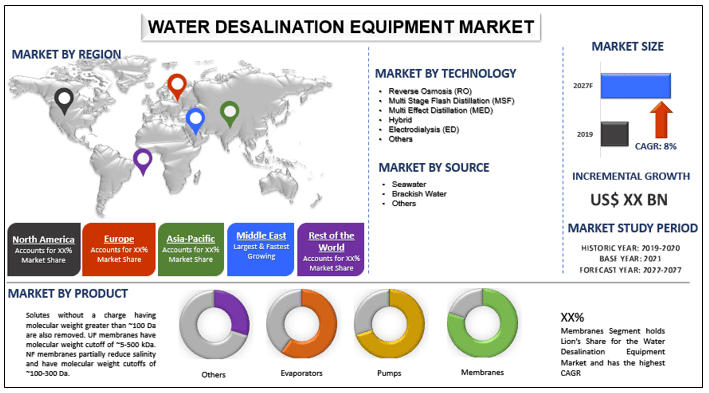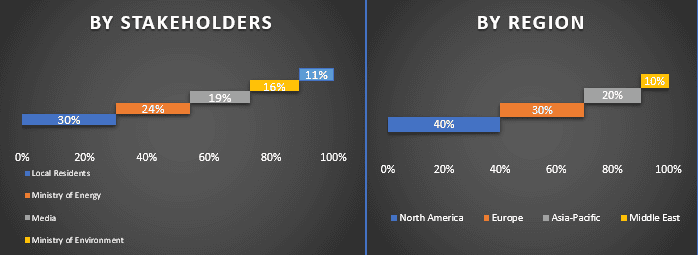- Trang chủ
- Về chúng tôi
- Ngành
- Dịch vụ
- Đọc
- Liên hệ với chúng tôi
Thị trường Thiết bị Khử muối Nước: Phân tích Hiện tại và Dự báo (2021-2027)
Chú trọng vào Công nghệ (Thẩm thấu ngược (RO), Chưng cất nhiều giai đoạn (MSF), Chưng cất đa hiệu ứng (MED), Hybrid, Điện thẩm tách (ED), Khác); Nguồn (Nước biển, Nước lợ, Khác); Sản phẩm (Màng lọc, Máy bơm, Thiết bị bay hơi, Khác); Khu vực/Quốc gia

Thị trường Thiết bị Khử muối Nước dự kiến sẽ vượt quá mức CAGR đáng kể khoảng 10% trong giai đoạn dự báo (2021-2027). Thiết bị khử muối và máy khử muối được sử dụng để tách muối khỏi nước và giảm độ mặn của nó. Khử muối được sử dụng trong các ứng dụng tái sử dụng nước tại các cơ sở tạo ra nước có độ mặn cao, thường được gọi là nước muối, như một sản phẩm phụ của các quy trình khác. Nước muối đã qua xử lý này có độ mặn thấp hơn và sau đó sẽ trải qua các quy trình xử lý nước tiên tiến để chuẩn bị cho các giai đoạn cuối cùng để trở thành nước uống. Mặc dù các hệ thống khử muối đang trở thành một ứng dụng phổ biến trên toàn thế giới, nhưng một số khu vực nhất định có nồng độ cao hơn do nhu cầu nước cao hơn. Hiện tại, có tới 18.000 nhà máy khử muối sử dụng các hệ thống này trên toàn cầu, tạo ra hơn 25.000 GPD. Gần một nửa số máy khử muối này tồn tại và hoạt động ở Trung Đông và Bắc Phi. Sự xuất hiện này chủ yếu là do khí hậu nóng và khô của các khu vực cụ thể này. Có sự tăng trưởng trong các hệ thống khử muối ở khu vực đó và dự kiến sẽ tăng cường trong vài thập kỷ tới thông qua Hoa Kỳ, Châu Á và Châu Mỹ Latinh. Những tiến bộ công nghệ trong các lĩnh vực này cuối cùng sẽ làm giảm tỷ lệ năng lượng cần thiết cho sản xuất nước, điều này cuối cùng dẫn đến các hệ thống khử muối hoạt động tích cực hơn.
Nước bao phủ 71% toàn bộ bề mặt trái đất, trong đó chỉ có 3% là nước ngọt có sẵn cho mục đích uống và nông nghiệp. Tiết kiệm nước là rất quan trọng để đảm bảo nguồn cung dài hạn cho tiêu dùng và các ứng dụng khác. 785 triệu người trên toàn thế giới không được tiếp cận với nước uống và ít nhất 2.000 triệu người sử dụng các nguồn nước uống bị ô nhiễm, theo UNICEF. Theo Liên Hợp Quốc (LHQ), mức tiêu thụ nước đã tăng 1% hàng năm kể từ những năm 1980 và xu hướng tăng trưởng tương tự dự kiến sẽ tiếp tục cho đến năm 2050, là do các yếu tố như tăng trưởng dân số nhanh chóng, phát triển kinh tế xã hội và thay đổi mô hình tiêu dùng. Đến năm 2030, gần một nửa dân số thế giới dự kiến sẽ phải đối mặt với tình trạng khan hiếm nước. Mối quan tâm chính khi sử dụng màng RO là sự đóng cặn xảy ra trên bề mặt màng hoặc lỗ chân lông của nó. Đóng cặn xảy ra ở cả màng làm từ cellulose và màng composite màng mỏng. Đóng cặn có thể có 4 loại, cụ thể là sinh học, đóng cặn, keo và hữu cơ. Độ bão hòa muối trên bề mặt màng là lý do chính gây ra đóng cặn trong các nhà máy khử muối và đóng cặn cũng làm giảm thông lượng và tuổi thọ của màng.
Công suất Khử muối của các Nhà máy Đang hoạt động trên Toàn thế giới Theo Khu vực (Triệu Mét Khối Mỗi Ngày), 2018

Suez Water Technologies & Solutions, Toray Industries, Inc., Wärtsilä, Advanced Watertek, LG Chem, Torishima Pump Mfg. Co., Ltd., Koch Separation Solutions, Veolia Water Technologies, Alfa Laval và Sulzer là một số công ty nổi bật hoạt động trong thị trường Thiết bị Khử muối Nước. Một số thương vụ M&A cùng với quan hệ đối tác đã được thực hiện bởi những người chơi này để tạo điều kiện cho khách hàng với các sản phẩm/công nghệ công nghệ cao và sáng tạo.
Thông tin chi tiết được trình bày trong báo cáo
“Trong số các Công nghệ, phân khúc Thẩm thấu Ngược (RO) chiếm phần lớn”
Dựa trên Công nghệ, Thị trường Thiết bị Khử muối Nước được phân chia thành Thẩm thấu Ngược (RO), Chưng cất Nhiều giai đoạn (MSF), Chưng cất Nhiều Hiệu ứng (MED), Hybrid, Điện thẩm tách (ED) và Các loại khác. Công nghệ SWRO (RO nước biển) có một số ưu điểm so với các kỹ thuật khử muối khác bao gồm hiệu quả và độ chọn lọc cao, dễ dàng mở rộng và kiểm soát, phù hợp và linh hoạt cho các ứng dụng tích hợp. Tuy nhiên, nhược điểm chính của công nghệ RO là mức sử dụng năng lượng cao hơn đáng kể so với các hình thức xử lý nước uống thay thế khác.
“Trong số các Nguồn, phân khúc Nước biển chiếm phần lớn”
Dựa trên Nguồn, Thị trường Thiết bị Khử muối Nước được phân chia thành Nước biển, Nước lợ và Các loại khác. Đại dương chiếm 70% bề mặt trái đất và chiếm 96% lượng nước trên hành tinh. Tình trạng khan hiếm tài nguyên nước ngọt và nhu cầu về nguồn cung cấp nước bổ sung đã trở nên quan trọng ở nhiều khu vực khô cằn trên thế giới và sẽ ngày càng trở nên quan trọng hơn trong tương lai.
“Trong số các Sản phẩm, phân khúc Màng chiếm phần lớn”
Dựa trên Sản phẩm, thị trường Thiết bị Khử muối Nước được phân chia thành Màng, Máy bơm, Thiết bị bay hơi và Các loại khác. Có nhiều loại màng khác nhau cho các quy trình màng khác nhau để làm sạch và khử muối nước bao gồm vi lọc (MF), siêu lọc (UF), thẩm thấu ngược (RO), lọc nano (NF), chưng cất màng (MD), màng trao đổi ion và thẩm thấu xuôi (FO). Nguyên tắc tách trong các quy trình này chủ yếu dựa trên kích thước khác nhau của các phân tử và các vật thể khác (MF, UF và NF), điện tích ion của các phân tử và bề mặt màng (NF, FO và RO), tính kỵ nước (MD) và phân cực điện (màng trao đổi ion).
“Trung Đông đại diện cho một trong những thị trường lớn nhất của thị trường Thiết bị Khử muối Nước”
Để hiểu rõ hơn về động lực thị trường của thị trường Thiết bị Khử muối Nước, một phân tích chi tiết đã được thực hiện cho các khu vực khác nhau trên khắp Ấn Độ bao gồm Bắc Mỹ (Mỹ, Canada, Phần còn lại của Bắc Mỹ), Châu Âu (Đức, Anh, Pháp, Tây Ban Nha, Ý, Phần còn lại của Châu Âu), Châu Á-Thái Bình Dương (Trung Quốc, Nhật Bản, Ấn Độ, Úc, Phần còn lại của Châu Á-Thái Bình Dương), Trung Đông (Qatar, Bahrain, Kuwait, Các Tiểu vương quốc Ả Rập Thống nhất, Ả Rập Saudi, Phần còn lại của Trung Đông), Phần còn lại của Thế giới. Trung Đông thống trị thị trường và chiếm phần lớn thị phần vào năm 2020.
Lý do nên mua báo cáo này:
- Nghiên cứu bao gồm phân tích kích thước và dự báo thị trường được xác thực bởi các chuyên gia hàng đầu trong ngành
- Báo cáo trình bày một đánh giá nhanh về hiệu suất tổng thể của ngành trong nháy mắt
- Báo cáo bao gồm phân tích chuyên sâu về các đối thủ cùng ngành nổi bật với trọng tâm chính là tài chính kinh doanh chính, danh mục sản phẩm, chiến lược mở rộng và các phát triển gần đây
- Kiểm tra chi tiết các động lực, hạn chế, xu hướng chính và cơ hội hiện có trong ngành
- Nghiên cứu bao gồm toàn diện thị trường trên các phân khúc khác nhau
- Phân tích sâu sắc về ngành ở cấp độ khu vực
Tùy chọn tùy chỉnh:
Thị trường Thiết bị Khử muối Nước có thể được tùy chỉnh thêm theo yêu cầu hoặc bất kỳ phân khúc thị trường nào khác. Bên cạnh đó, UMI hiểu rằng bạn có thể có nhu cầu kinh doanh riêng, vì vậy hãy thoải mái liên hệ với chúng tôi để nhận được một báo cáo hoàn toàn phù hợp với yêu cầu của bạn.
Mục lục
Phân tích thị trường lịch sử, ước tính thị trường hiện tại và dự báo thị trường tương lai của Thiết bị khử muối nước là ba bước chính được thực hiện để tạo và phân tích việc áp dụng Thiết bị khử muối nước ở các khu vực lớn trên toàn cầu. Nghiên cứu thứ cấp chuyên sâu đã được tiến hành để thu thập số liệu thị trường lịch sử và ước tính quy mô thị trường hiện tại. Thứ hai, để xác thực những hiểu biết này, nhiều phát hiện và giả định đã được xem xét. Hơn nữa, các cuộc phỏng vấn sơ cấp chuyên sâu cũng đã được thực hiện với các chuyên gia trong ngành trên toàn bộ chuỗi giá trị của thị trường Thiết bị khử muối nước. Sau khi giả định và xác thực số liệu thị trường thông qua các cuộc phỏng vấn sơ cấp, chúng tôi đã sử dụng phương pháp tiếp cận từ trên xuống/từ dưới lên để dự báo quy mô thị trường hoàn chỉnh đến năm 2027. Sau đó, các phương pháp phân tích thị trường và tam giác dữ liệu đã được áp dụng để ước tính và phân tích quy mô thị trường của các phân khúc và phân khúc con mà ngành liên quan đến. Phương pháp luận chi tiết được giải thích dưới đây:
Phân tích Quy mô Thị trường Lịch sử
Bước 1: Nghiên cứu Chuyên sâu về Các Nguồn Thứ cấp:
Nghiên cứu thứ cấp chi tiết đã được thực hiện để thu thập quy mô thị trường lịch sử của Thiết bị khử muối nước thông qua các nguồn nội bộ của công ty như báo cáo thường niên & báo cáo tài chính, thuyết trình hiệu suất, thông cáo báo chí, v.v. và các nguồn bên ngoài bao gồm tạp chí, tin tức & bài viết, ấn phẩm của chính phủ, ấn phẩm của đối thủ cạnh tranh, báo cáo ngành, cơ sở dữ liệu của bên thứ ba và các ấn phẩm đáng tin cậy khác.
Bước 2: Phân khúc Thị trường:
Sau khi thu thập quy mô thị trường lịch sử của thị trường Thiết bị khử muối nước, chúng tôi đã tiến hành phân tích thứ cấp chi tiết để thu thập thông tin chi tiết về thị trường lịch sử và chia sẻ cho các phân khúc & phân khúc con khác nhau cho các khu vực lớn. Các phân khúc chính được bao gồm trong báo cáo là Công nghệ, Nguồn và Sản phẩm. Phân tích cấp quốc gia sâu hơn đã được thực hiện để đánh giá việc áp dụng chung Thiết bị khử muối nước ở khu vực đó.
Bước 3: Phân tích Yếu tố:
Sau khi có được quy mô thị trường lịch sử của các phân khúc và phân khúc con khác nhau, chúng tôi đã tiến hành phân tích yếu tố chi tiết để ước tính quy mô thị trường hiện tại của Thiết bị khử muối nước. Hơn nữa, chúng tôi đã tiến hành phân tích yếu tố sử dụng các biến phụ thuộc và độc lập như gia tăng dân số và nhu cầu nước, v.v. Một phân tích kỹ lưỡng đã được thực hiện cho các kịch bản phía cung và phía cầu xem xét các quan hệ đối tác hàng đầu, sáp nhập và mua lại, mở rộng kinh doanh và ra mắt sản phẩm trong lĩnh vực Thiết bị khử muối nước trên toàn cầu.
Ước tính & Dự báo Quy mô Thị trường Hiện tại
Định cỡ Thị trường Hiện tại: Dựa trên những hiểu biết sâu sắc có thể hành động từ 3 bước trên, chúng tôi đã xác định được quy mô thị trường hiện tại, những người chơi chính trong thị trường Thiết bị khử muối nước và thị phần của các phân khúc. Tất cả các tỷ lệ phần trăm chia sẻ cần thiết và phân tích thị trường đã được xác định bằng phương pháp thứ cấp đã đề cập ở trên và được xác minh thông qua các cuộc phỏng vấn sơ cấp.
Ước tính & Dự báo: Để ước tính và dự báo thị trường, trọng số đã được gán cho các yếu tố khác nhau bao gồm các động lực & xu hướng, hạn chế và cơ hội có sẵn cho các bên liên quan. Sau khi phân tích các yếu tố này, các kỹ thuật dự báo có liên quan, tức là phương pháp tiếp cận từ trên xuống/từ dưới lên, đã được áp dụng để đưa ra dự báo thị trường khoảng năm 2027 cho các phân khúc và phân khúc con khác nhau trên các thị trường lớn trên toàn cầu. Phương pháp nghiên cứu được áp dụng để ước tính quy mô thị trường bao gồm:
- Quy mô thị trường của ngành, về giá trị (US$) và tỷ lệ áp dụng Thiết bị khử muối nước trên các thị trường lớn trong nước
- Tất cả các tỷ lệ phần trăm chia sẻ, chia tách và phân tích các phân khúc và phân khúc con của thị trường
- Những người chơi chính trong thị trường Thiết bị khử muối nước về các sản phẩm được cung cấp. Ngoài ra, các chiến lược tăng trưởng được các công ty này áp dụng để cạnh tranh trong thị trường đang phát triển nhanh chóng
Xác thực Quy mô và Thị phần Thị trường
Nghiên cứu Sơ cấp: Các cuộc phỏng vấn chuyên sâu đã được thực hiện với những người dẫn đầu quan điểm chủ chốt (KOL) bao gồm các giám đốc điều hành cấp cao nhất (CXO/VP, Trưởng phòng Kinh doanh, Trưởng phòng Tiếp thị, Trưởng phòng Điều hành và Trưởng phòng Khu vực, Trưởng phòng Quốc gia, v.v.) trên khắp các khu vực lớn. Các phát hiện nghiên cứu sơ cấp sau đó đã được tóm tắt và phân tích thống kê đã được thực hiện để chứng minh giả thuyết đã nêu. Thông tin đầu vào từ nghiên cứu sơ cấp đã được hợp nhất với các phát hiện thứ cấp, do đó biến thông tin thành những hiểu biết sâu sắc có thể hành động.
Phân chia Người tham gia Sơ cấp ở các Khu vực Khác nhau

Kỹ thuật Thị trường
Kỹ thuật tam giác dữ liệu đã được sử dụng để hoàn thành việc ước tính thị trường tổng thể và để đưa ra các số liệu thống kê chính xác của từng phân khúc và phân khúc con của thị trường Thiết bị khử muối nước. Dữ liệu được chia thành nhiều phân khúc & phân khúc con sau khi nghiên cứu các thông số và xu hướng khác nhau trong các lĩnh vực loại hình và loại hình của thị trường Thiết bị khử muối nước.
Mục tiêu chính của Nghiên cứu Thị trường Thiết bị khử muối nước
Các xu hướng thị trường hiện tại & tương lai của Thiết bị khử muối nước đã được xác định trong nghiên cứu. Các nhà đầu tư có thể thu được những hiểu biết sâu sắc về chiến lược để làm cơ sở cho quyết định đầu tư của họ từ phân tích định tính và định lượng được thực hiện trong nghiên cứu. Các xu hướng thị trường hiện tại và tương lai đã xác định sức hấp dẫn tổng thể của thị trường ở cấp khu vực, cung cấp một nền tảng cho người tham gia công nghiệp khai thác thị trường chưa được khai thác để hưởng lợi với tư cách là người tiên phong. Các mục tiêu định lượng khác của các nghiên cứu bao gồm:
- Phân tích quy mô thị trường hiện tại và dự báo của Thiết bị khử muối nước về giá trị (US$). Ngoài ra, hãy phân tích quy mô thị trường hiện tại và dự báo của các phân khúc và phân khúc con khác nhau
- Các phân khúc trong nghiên cứu bao gồm các lĩnh vực loại hình và các loại hình phụ của chúng
- Xác định và phân tích khung pháp lý cho ngành Thiết bị khử muối nước
- Phân tích chuỗi giá trị liên quan đến sự hiện diện của các trung gian khác nhau, cùng với việc phân tích hành vi của khách hàng và đối thủ cạnh tranh của ngành
- Phân tích quy mô thị trường hiện tại và dự báo của thị trường Thiết bị khử muối nước cho khu vực lớn
- Các khu vực lớn được nghiên cứu trong báo cáo bao gồm Bắc Mỹ (Mỹ, Canada, Phần còn lại của Bắc Mỹ), Châu Âu (Đức, Anh, Pháp, Tây Ban Nha, Ý, Phần còn lại của Châu Âu), Châu Á - Thái Bình Dương (Trung Quốc, Nhật Bản, Ấn Độ, Úc, Phần còn lại của Châu Á - Thái Bình Dương), Trung Đông (Qatar, Bahrain, Kuwait, Các Tiểu vương quốc Ả Rập Thống nhất, Ả Rập Saudi, Phần còn lại của Trung Đông), Phần còn lại của Thế giới.
- Hồ sơ công ty của thị trường Thiết bị khử muối nước và các chiến lược tăng trưởng được những người chơi trên thị trường áp dụng để duy trì trong thị trường đang phát triển nhanh chóng
- Phân tích cấp quốc gia chuyên sâu về ngành
Liên quan Báo cáo
Khách hàng đã mua mặt hàng này cũng đã mua










